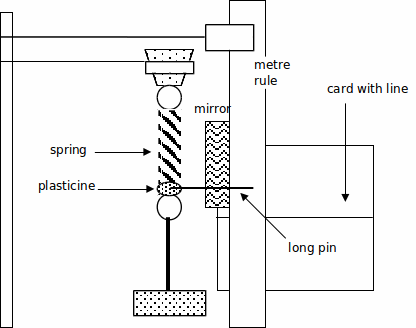Apparatus:
Spring and cork, tall retort stand/clamp/boss, set of 100g masses with holder, mirror, long pin, small piece of plasticine, stop watch, plumb line, one metre rule, card with line.

Procedure:
1. Hang the spring vertically from a stand and attach the optical pin pointer onto the end of the spring using a small piece of plasticine. Clamp the metre ruler vertically (check with the plumb line) next to the spring.
2. Note the initial level (![]() /m) of the optical pin against the ruler, use the mirror to check that your eye is at the same level as the pin.
/m) of the optical pin against the ruler, use the mirror to check that your eye is at the same level as the pin.
3. Hang a mass,![]() (100g plus the mass holder) and then note the new pin level (
(100g plus the mass holder) and then note the new pin level (![]() /m) and so calculate the spring extension,
/m) and so calculate the spring extension,![]() where
where![]()
4. Now displace this mass from its equilibrium position and release. Measure the time for![]() oscillations
oscillations
(![]() should be at least 5). Use the line on the card, placed at the mid-point of the oscillations, when counting oscillations. Repeat and so calculate the average time for
should be at least 5). Use the line on the card, placed at the mid-point of the oscillations, when counting oscillations. Repeat and so calculate the average time for![]() oscillations.
oscillations.
Finally calculate the period for one oscillation,![]() /s and also
/s and also![]() / s 2 .
/ s 2 .
5. Repeat stages 2 to 4 for four other values of![]() (maximum 700g).
(maximum 700g).
6. Tabulate ALL of your measurements & results.
7. Plot the following graphs: (a) mass,![]() / kg against extension,
/ kg against extension,![]() / m. (b)
/ m. (b)![]() / s 2 against
/ s 2 against![]() / kg. Both graphs should be straight lines.
/ kg. Both graphs should be straight lines.
8. The extension,![]() caused by a mass,
caused by a mass,![]() of weight,
of weight,![]() are related by
are related by![]() (1). The period of oscillation of a mass hung from a spring is given by
(1). The period of oscillation of a mass hung from a spring is given by![]() (2) (where, in both cases,
(2) (where, in both cases,![]() ). When squared the second equation becomes
). When squared the second equation becomes![]()
The gradient of your first graph,![]() is equal to
is equal to![]() It can be shown that the gradient of the second graph,
It can be shown that the gradient of the second graph,![]() is given by
is given by![]() hence
hence![]() Use your graph gradients, and the above relationship, to find a value for the gravitational field strength,
Use your graph gradients, and the above relationship, to find a value for the gravitational field strength,![]() and for the spring constant,
and for the spring constant,![]()
9 (a) How, if at all, would your graphs and results be different if you were to perform this experiment on the moon?
(b) Show how the expression,![]() is obtained starting from (1) & (2).
is obtained starting from (1) & (2).
